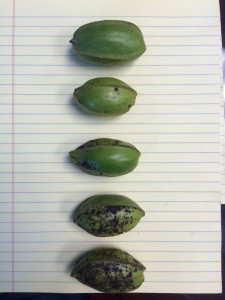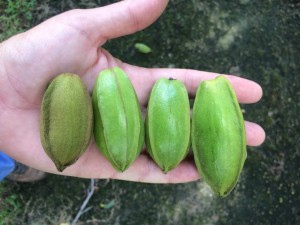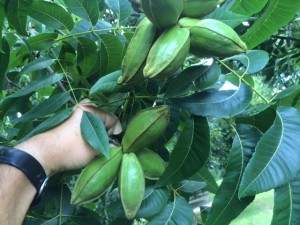Here is a nice article from Lenny Wells covering three newer pecan cultivars,
The topic of cultivars is an endless source of discussion for pecan growers. We are always on the lookout for the perfect cultivar but in reality it probably doesn’t exist. Every orchard situation is different and there are problems with any cultivar you can name if you look hard enough. With that being said, I’ll share with you a few observations I made on cultivars following a walk I took this week in the UGA Variety Trial at the Ponder Research Farm in Tifton.
Much of this brief discussion regards cultivars that many of you may never have heard of or have never seen in the flesh. These are cultivars that we are on the edge of considering recommending for trial. Its always a scary feeling recommending a new cultivar. You never know what problems may arise as the cultivar is more widely planted. But the more I look at a few of these and compare them with what is already being planted out there, the more I tell myself, why not.
Let’s start off with a look at how ‘Desirable is faring. This orchard has only been sprayed 9 times with fungicide in 2015. Scab is certainly present (UGA pecan breeder, Dr. Patrick Conner, wants some level of scab to compare between varieties) but not so bad that the crop will be lost. The image below gives an idea of the range of scab severity on ‘Desirable’ from the same tree:
 Pecan scab on ‘Desirable’ from UGA Ponder Farm Variety Orchard 8/24/2015
Pecan scab on ‘Desirable’ from UGA Ponder Farm Variety Orchard 8/24/2015
Most of the “Desirable’ nuts on these trees would look like the first 3. I would say 25% or less (mostly at the top of the tree) look like the 2 nuts on the bottom. All of these nuts will make, although there may be a little bit of a quality drop on the bottom nut. This gives you a good idea of the scab pressure here with the spray program we’ve used.
With this in mind, let’s look at a few cultivars I feel are at least worth taking a close look at:
 From left to right: McMillan, Cherryle, Desirable, Nacono
From left to right: McMillan, Cherryle, Desirable, Nacono
Three of the varieties I wanted to share with you are McMillan, Cherryle, and Nacono. We have recommended McMillan as a good choice for low-input orchards for quite some time now. It is a seedling selection from Alabama, has a rough appearance to the shuck, very low scab incidence, no problems with black aphids, very good, consistent yields, decent quality (50% kernel) and is large enough at 51-55 nuts per lb to go to the in-shell export market. The more I watch this cultivar the more I like it—not just for low input orchards. This is a commercial cultivar in my opinion based on the current in-shell market. I consider it to be as good as Stuart with less disease and insect pressure. So, if you’re tired of spraying fungicides 10-15 times, I would consider this one.
Cherryle (pronounced Cherry Lee) is another seedling selection originating in Grand Bay, Alabama. We keep waiting for something serious to go wrong with this cultivar but we have been pleasantly surprised each year. Cherryle has an October 11 harvest date, large nut size (40 nuts per lb), excellent quality (56% kernel) and although its not really a precocious cultivar it produces good yields when it gets going. It also has good scab resistance in Tifton. I believe most locations in Georgia could keep Cherryle clean with 2 or 3 fungicide sprays. Perhaps less than that in middle Georgia. This is one I would plant for trial myself. I’m beginning to place almost as much emphasis on a cultivar that is not preferred by black aphids as I do on scab resistance. Like McMillan, Cherryle doesn’t have problems with black aphids. There is really only one problem with Cherryle that I see so far and that is suture split—a splitting of the shell when the nuts lay on the ground in the sun following shaking , which can occur due to the thin shell drying down faster than the kernel inside, much like you can see with Schley from time to time. But, I consider this a minor problem at this point. The tree still produces good yields even with the suture split.
‘Nacono’ is a nut that just looks ridiculously good this time of year. It produces big clusters of long, huge nuts that look like bananas hanging from the tree.
This is a USDA cultivar with 42 nuts per lb, 53% kernel, and October 6 harvest date. Yields have been very good. This tree will alternate bear as do most precocious cultivars with big clusters of large nuts, but it is impressive. It scabbed some in 2009 before the orchard was on as good of a spray program. So, it can scab but since then, with a decent spray program I have seen no real scab problems, including the wet year of 2013, and no insect problems. I think you could easily make ‘Nacono’, particularly in middle Georgia, with a 4-8 spray fungicide program. The size of the nut scares me a little because the first thing that comes to mind is ‘Mahan’ but there is really no comparison. ‘Nacono’ fills much better and produces a much nicer kernel than ‘Mahan’. This is another cultivar in which we keep looking for something wrong but it continues to impress. Anytime we are visited by a Chinese delegation, they go crazy over this nut, so obviously it should bring a good price, particularly so early, on the in-shell market. Domestic buyers have been impressed with this nut as well. We’re still on the fence with an official recommendation for this one, but personally I would try it.
I’ll share my opinion on a few more cultivars soon but in the meantime for more information on these and many other cultivars, see Dr. Patrick Conner’s website here.

